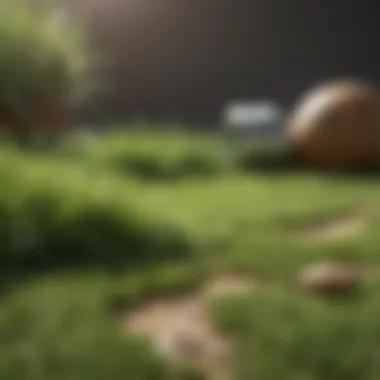The Best Lawn Feed: Nutrients and Techniques for Growth


Intro
Maintaining a lush and healthy lawn is a pursuit that many homeowners cherish. Grass requires proper nutrients, and selecting the right lawn feed is crucial for its growth. Various products exist, each with unique components tailored for specific needs. This guide aims to dissect various lawn feed options to enhance your lawn's vitality.
Understanding the balance of nutrients, the timing of application, and sustainable practices can optimize lawn care. Whether you are a novice or seasoned in lawn maintenance, knowing the best approaches will foster a thriving green space.
Essential Nutrients for Lawn Growth
Nutrients are fundamental for promoting healthy grass. Here are the primary components that any lawn feed should contain:
- Nitrogen: Vital for leaf growth and greenness.
- Phosphorus: Crucial for root development and flowering.
- Potassium: Supports overall health, drought resistance, and recovery from stress.
These nutrients interact in complex ways, making their balance essential. Improper ratios can lead to weak growth or disease susceptibility.
Types of Lawn Feed
Lawn feeds come in various forms. Each type serves distinct purposes:
- Granular Fertilizers: Easy to apply, slow-release options ideal for long-term nourishment.
- Liquid Fertilizers: Quick-acting, suitable for immediate nutrient boost, but require more frequent applications.
- Organic Options: These include compost or manure, often containing helpful microorganisms that enhance soil health.
It's important to select the most suitable type based on your lawn’s specific needs and your personal care regime.
Application Techniques
Proper application methods can influence the effectiveness of lawn feed. Here are best practices:
- Timing: Apply during peak growing seasons like spring and fall.
- Weather Conditions: Ensure soil is moist but not overly saturated before application.
- Even Distribution: Use a spreader for granular feeds to guarantee uniform coverage.
- Follow Instructions: Always adhere to product recommendations for quantity and frequency.
Mistakes in application can hinder growth, so careful planning is essential.
Sustainable Lawn Feeding Practices
Sustainability is increasingly significant in lawn care. Here are effective practices:
- Soil Testing: Understand existing nutrient levels to avoid over-fertilization.
- Using Native Plants: Incorporate species that require less fertilizer and are well-adapted to local conditions.
- Mulching: Grass clippings can return valuable nutrients to the soil.
Adopting these practices fosters a healthier ecosystem and preserves resources.
Culmination
Finding the best lawn feed requires knowledge of its components, types, and application methods. By considering both efficiency and sustainability, you can cultivate a lawn that is not only beautiful but also environmentally friendly. Making informed decisions about lawn care will lead to greater satisfaction and a thriving outdoor space.
Understanding Lawn Nutrition
Understanding lawn nutrition is a fundamental aspect of maintaining a healthy and vibrant lawn. It integrates the science of soil composition, plant biology, and environmental conditions, providing insights into how to best nourish turf grasses for optimum growth. Having a firm grasp of the nutritional needs of your lawn can make a significant difference in its appearance and resilience against pests and diseases. Each nutrient plays a unique role, influencing everything from growth rates to coloration and overall plant vigor.
The key to a lush lawn lies in a balanced nutrient profile, which fosters robust root development and enhances stress resistance.
The Role of Nitrogen, Phosphorus, and Potassium


Nitrogen, phosphorus, and potassium, often referred to as N-P-K, form the backbone of lawn fertilization. Each component has distinct functions: nitrogen is primarily responsible for growth and greening, phosphorus promotes root development and flowering, while potassium helps with disease resistance and drought tolerance.
- Nitrogen is critical for leafy growth; it stimulates the formation of chlorophyll, which is essential for photosynthesis. A nitrogen-rich lawn feed can quickly turn a dull lawn into a vibrant green expanse. However, over-application can lead to lush growth that is weak and susceptible to diseases.
- Phosphorus helps anchor roots and increases strength, allowing grass to absorb water efficiently. It is particularly important during the establishment phase of a lawn or when overseeding. However, excessive phosphorus can run off into water bodies, leading to pollution.
- Potassium is vital for overall plant health. It helps the plant endure stress from drought, low temperatures, and diseases. Lawn feeds rich in potassium will improve the lawn's ability to withstand environmental challenges, ensuring it remains healthy under varying conditions.
Understanding these three elements is crucial for selecting the right type of lawn feed and applying it in appropriate amounts to meet the specific needs of your lawn.
Micro-nutrients: Why They Matter
While nitrogen, phosphorus, and potassium are critical, micro-nutrients should not be overlooked. Elements such as iron, manganese, zinc, and copper are required in smaller quantities but are equally important for lawn health.
- Iron can enhance the green color of grass without promoting excessive growth. It is particularly useful in soils with high pH where iron deficiency is common.
- Manganese supports photosynthesis and aids in plant metabolism. Deficiencies can result in yellowing leaves, impacting overall growth.
- Zinc is involved in enzyme function and protein synthesis, influencing the vigor of the grass.
- Copper helps in the formation of reproductive structures and plays a role in disease resistance.
While these micro-nutrients are needed in smaller amounts, their deficiency can lead to significant issues. Regular soil testing allows you to understand your lawn's specific needs, ensuring that both macro and micro-nutrients are adequately supplied for vibrant, healthy growth.
Types of Lawn Feed
Understanding the types of lawn feed is crucial for anyone looking to maintain or enhance their green spaces. The right choice can significantly impact lawn health, growth rate, and resilience against pests and diseases. Different feed options come with their unique compositions and application methods. Knowing these allows homeowners to tailor their feeding strategies according to specific lawn needs and seasonal changes.
Granular Lawn Fertilizers
Granular lawn fertilizers are perhaps the most common type. They come in dry form and release nutrients gradually into the soil. This slow-release mechanism provides a steady nutrient supply over time, reducing the risk of nutrient leaching and loss. Granular fertilizers are also relatively easy to apply with a spreader, ensuring uniform distribution.
- Benefits: Their slow-release nature allows for less frequent applications, which can save time and resources.
- Considerations: It's important to ensure that the granules break down effectively. Poor-quality products may lead to uneven nutrient supply.
When using granular treatments, timing is key. Spring and fall tend to be the optimal seasons for application, allowing nutrients to align with the lawn's natural growth cycles.
Liquid Lawn Fertilizers
Liquid lawn fertilizers are another popular option, typically applied via spraying. They offer quick nutrient absorption, making them ideal for scenarios when fast results are needed. Liquid feeds can benefit stressed lawns or areas that require immediate attention.
- Benefits: They often penetrate the soil better and can be mixed with other treatments, such as pesticides.
- Considerations: Liquid options generally require more frequent applications than granular ones, which can demand more effort.
It’s worth noting that liquid fertilizers may be less stable under certain weather conditions. Rain can wash away nutrients if applied before a storm, so monitoring the weather is crucial.
Organic vs.
Synthetic Options
The choice between organic and synthetic lawn feed has implications for both lawn health and environmental impact. Organic fertilizers consist of natural materials such as compost, manures, and meal products. They provide not only nutrients but also improve soil structure and biodiversity.
- Benefits of Organic: They contribute to long-term soil health, can reduce chemical runoff, and are generally safer for pets and children.
- Challenges: Organic options often require more frequent applications and may take longer to show results, as they rely on natural breakdown processes.
On the other hand, synthetic fertilizers are manufactured, combining specific nutrients to achieve desired nutrient ratios. They provide immediate nutrient availability, allowing for rapid lawn response.
- Benefits of Synthetic: They can be precisely formulated for specific needs and often yield instant results.
- Concerns: Overuse can lead to soil degradation and environmental damage, especially through runoff into local water bodies.
Choosing the Right Lawn Feed
Choosing the right lawn feed is crucial for maintaining a vibrant and healthy lawn. Different types of grass have varying nutritional needs, and an appropriate selection promotes not only growth but also resilience against pests and disease. Understanding these requirements prevents wasted resources and ensures a balanced ecosystem in your lawn.


Assessing Your Lawn's Nutritional Needs
To make informed decisions, one must begin by assessing their lawn's specific nutritional needs. Different grasses have distinct preferences for nutrients. For example, Kentucky bluegrass generally prefers a nitrogen-rich feed while fescue thrives with a balanced multi-nutrient approach. Knowing the type of grass and its growth stage is vital. Young grass may need more nitrogen to promote lush growth, while mature grass may benefit from a balanced feed to maintain strength and vitality. Observe if the lawn appears (green and dense) or shows signs of stress like yellow patches. This observation assists in determining the appropriate feed.
Soil Testing: The First Step
Soil testing stands as an essential first step in selecting lawn feed. A soil test reveals pH levels, nutrient levels, and deficiencies in trace elements. Numerous local agricultural extension offices offer this testing service, or you can purchase a DIY kit. Understanding your soil composition allows for more targeted feed choices.
For example, if the soil test indicates a low phosphorus level, consider a lawn feed that supplies this nutrient adequately. Considerations from the soil test often guide the appropriate nutrient mix, enhancing performance and effectiveness. The ultimate goal is to create a healthy soil environment that fosters optimal grass growth.
Seasonal Considerations in Lawn Feeding
The timing and type of lawn feed also depend heavily on seasonal changes. Each season presents unique challenges and requirements for lawns. In spring, the focus should be on promoting growth as the grass begins to awaken. A high nitrogen fertilizer can support this. As summer arrives, transitioning to a more balanced fertilizer helps sustain health without overstimulating growth during hot months. In the fall, it is important to prepare the lawn for winter, thus opting for a feed that is rich in potassium can enhance root strength and disease resistance.
Understanding these seasonal requirements not only maximizes lawn health but also minimizes the impact of lawn care practices on the environment. By aligning application strategies with seasonal needs, the lawn can effectively thrive throughout the changing conditions.
Application Techniques
Effective application techniques are critical for ensuring that lawn feed provides the intended benefits. Applying the right fertilizer in the correct way maximizes nutrient absorption and minimizes the risk of waste or damage to your grass. Neglecting these practices may lead to uneven growth, lawn discoloration, or even detrimental environmental impact.
Best Practices for Granular Application
Granular fertilizers are popular due to their ease of handling and precise application. To optimize their effectiveness, follow these best practices:
- Even Distribution: Use a broadcast spreader to evenly distribute granules across the lawn. This tool helps achieve a consistent application rate.
- Watering After Application: Immediately watering after granular application helps dissolve the fertilizer and begins the nutrient absorption process. Aim for about half an inch of water.
- Avoid Windy Days: Apply granular fertilizers on calm days. Wind can cause uneven spreading and loss of product to adjacent areas.
The technique of granular application can significantly affect its effectiveness. Choosing the right spreader and familiarizing yourself with the settings can lead to better results and a healthier lawn.
Proper Use of Liquid Fertilizers
Liquid fertilizers offer rapid absorption and immediate effects, making them an appealing option for many. However, improper use can lead to waste or injury to the grass. Here are some guidelines for effective application:
- Dilution according to the label: Always follow the manufacturer’s instructions regarding dilution rates to avoid causing harm to your lawn.
- Avoid Midday Application: The heat of the day can cause fertilizer to evaporate or burn the grass. Opt for early morning or late afternoon applications.
- Utilize a Sprayer: For an even coat, use a sprayer designed for lawn applications. Ensure that the nozzle is set correctly for a fine mist, which allows for even distribution.
Proper use can mean the difference between a thriving lawn and one that shows signs of distress.
Timing Your Lawn Feeding
Timing is an essential element of successful lawn feeding. Applying nutrients at the wrong time can render your efforts ineffective. Consider these points when determining when to feed:
- Seasonal Nutrient Needs: Lawns typically require different nutrients according to the season. Early spring is a good time for high nitrogen feeds to encourage growth. In contrast, fall feeding should focus on phosphorus to strengthen roots for winter.
- Weather Considerations: Avoid feeding during extreme weather conditions, such as drought or heavy rain. Dry soil can lead to nutrient runoff, while wet soil can impede absorption.
- Growth Patterns: Understanding your specific grass type can help determine optimal feeding times. Cool-season grasses typically need feeding in the early spring and fall, while warm-season varieties thrive on summer feeding.
Timely application of lawn feed can greatly enhance the vibrancy and health of your turf, providing long-lasting benefits.
Common Pitfalls in Lawn Care
Understanding common pitfalls in lawn care is essential for achieving and maintaining a healthy lawn. These mistakes can lead to wasted time, effort, and resources. Moreover, addressing these issues proactively can enhance the overall condition of green spaces. Over-fertilization and under-fertilization are two significant problems that many lawn caretakers face.
Over-fertilization Issues


Over-fertilization is a common mistake that can occur when people apply too much lawn feed. This can lead to several problems, including nutrient burn. When the concentration of nutrients is too high, the grass can suffer from damage, appearing brown or scorched. This not only harms the grass but also encourages weed growth.
Too much fertilizer can cause leaching, which means the excess nutrients wash away into the surrounding environment. This runoff can harm local waterways, leading to issues like algal blooms. Furthermore, it can disrupt the soil ecosystem. Grass may become reliant on added nutrients, weakening its ability to thrive naturally.
To avoid over-fertilization, follow the recommended application rates on the fertilizer package. Additionally, considering soil testing can provide insights into the specific needs of your lawn. It ensures you add nutrients only as necessary, benefiting both the grass and the surrounding environment.
Under-fertilization Consequences
On the other hand, under-fertilization is equally detrimental to lawn health. Without adequate nutrients, grass cannot photosynthesize effectively, leading to stunted growth. The grass will often appear pale or yellowish, indicating a deficiency in essential elements like nitrogen. An undernourished lawn is more susceptible to pests and diseases, as it lacks the vigor needed to fend off these threats.
Additionally, under-fertilized lawns may require more water. As the grass struggles to perform essential functions, it can lead to increased stress, especially during dry periods. It becomes necessary to find a balance, providing enough nutrients to promote healthy growth while avoiding the pitfalls of over-fertilization.
An effective way to prevent these issues includes regular soil testing, assessing the lawn's performance, and adjusting the fertilization approach accordingly. It helps in maintaining a green, lush lawn that thrives under appropriate care.
Understanding the balance of nutrients is vital. Both over and under-fertilization can compromise lawn health.
Sustainable Lawn Feeding Practices
Sustainable lawn feeding practices are essential for maintaining a healthy lawn while minimizing environmental impact. This section explores practical methods that not only nourish the grass but also contribute positively to the ecosystem. Sustainable practices foster soil health, reduce reliance on chemical fertilizers, and promote biodiversity. Implementing these methods can lead to a resilient lawn that thrives without depleting natural resources.
Composting as a Nutrient Source
Composting is a highly effective way to recycle organic materials into valuable nutrient sources for your lawn. By breaking down kitchen scraps, yard waste, and other organic matter, compost creates a rich soil amendment that nourishes your grass without the negative effects of synthetic fertilizers.
Benefits of Composting:
- Nutrient-Rich: Compost contains essential nutrients such as nitrogen, phosphorus, and potassium. These nutrients are released slowly, providing your lawn with a steady supply of nourishment over time.
- Improves Soil Structure: Adding compost enhances soil structure, promoting better aeration and drainage. This leads to healthy root development, which is vital for a thriving lawn.
- Microbial Activity: Compost encourages beneficial microbes that improve soil health. These microbes help break down organic matter, making nutrients more available to plants.
- Water Retention: Well-amended soil holds moisture more effectively, reducing the need for frequent watering.
To create compost, consider these main steps:
- Collect Organic Waste: Gather kitchen scraps like fruit and vegetable peels, as well as garden debris such as leaves and grass clippings.
- Create a Compost Pile: Layer the collected materials in a designated area or compost bin. Maintain a mix of green (nitrogen-rich) and brown (carbon-rich) materials for optimum decomposition.
- Turn Regularly: Turn the pile every few weeks to aerate it, which helps speed up the composting process.
- Harvest your Compost: After a few months, you will have dark, crumbly compost ready to apply to your lawn. This can be spread evenly on the soil surface or mixed into the soil directly.
Utilizing Grass Clippings
Another sustainable practice involves leaving grass clippings on the lawn after mowing. This simple act can greatly enhance lawn health and provide several benefits to both the grass and the environment.
Advantages of Leaving Grass Clippings:
- Nutrient Recycling: Grass clippings are a natural source of nitrogen. As they decompose, they return valuable nutrients to the soil, reducing the need for additional fertilizers.
- Moisture Conservation: Clippings help retain soil moisture by creating a barrier that reduces evaporation. This can lower irrigation needs, especially in warmer months.
- Weed Suppression: A layer of grass clippings can hinder weed growth by blocking sunlight, making it more difficult for weeds to germinate.
- Time-Saving: Not collecting clippings saves time and effort during mowing, allowing for quick maintenance of your lawn.
For those concerned about clumping or the aesthetic of their lawn, following these guidelines can enhance the effectiveness of using grass clippings:
- Mow Regularly: Aim to mow when the grass is not overly tall. This prevents clumping and allows for even distribution of clippings.
- Adjust Mower Height: Familiarize yourself with your mower’s height settings. Keeping the blade sharp and adjusting the height helps prevent uneven cuts.
- Spread Clippings Evenly: If clumps form, use a rake or lawnmower designed to chop clippings to improve their distribution.
Finale: Making Informed Choices
In the pursuit of a thriving lawn, it is essential to consider various factors that influence growth and health. Understanding the complexities of lawn nutrition, coupled with an awareness of different feeding options, lays the groundwork for making informed decisions. This article has outlined critical elements ranging from nitrogen, phosphorus, and potassium ratios to the effectiveness of organic and synthetic fertilizers.
One significant takeaway from the discussion is the role of proper application techniques. Whether using granular or liquid products, adherence to best practices maximizes nutrient uptake while minimizing waste. Furthermore, awareness of timing is paramount in ensuring that the lawn receives nourishment when it is most beneficial. Seasonal considerations affect not only how but when to apply feeds.
The pitfalls discussed, such as over-fertilization and under-fertilization, stress the necessity of a balanced approach. Mistakes in lawn care can lead to detrimental outcomes, hindering the very growth one aims to achieve. By addressing these common issues proactively, individuals can avoid setbacks in their lawn management journey.
Sustainable practices emerge as an essential theme throughout this guide. Composting and utilizing grass clippings serve as beneficial strategies that enhance soil health while reducing chemical inputs. In a world increasingly focused on environmental impact, these practices do not only improve lawn quality but also contribute positively to ecosystem health.
Ultimately, the choices one makes in lawn feeding should stem from careful assessment of the lawn’s specific nutritional needs and soil characteristics. Knowledge gained from soil testing can direct suitable fertilization strategies. This thoughtful methodology cultivates a lawn that is not only lush but also resilient over time.
"A well-informed decision today paves the way for a more vibrant lawn tomorrow."







